Paska Easter Bread
Traditional Paska Bread makes a sweet and delightful addition to your Easter table. This easy-to-make sweet bread uses pantry staple ingredients to make a soft and tender loaf of bread. Studded with golden raisins and a braided top, this delicious bread is the perfect addition to your Easter celebrations.

My mom’s side of the family is Italian and that is where I get the majority of my Easter recipes; things like Italian Easter Bread, Pigu, Bacon and Cheese Easter Bread, and Italian Easter Pie. On my dad’s side of the family, my grandmother is Polish and my grandfather was Irish. I don’t know as much about those food traditions, but I’m trying to take the opportunity each year to learn more.
A while ago, my grandma shared this recipe for Paska bread with me. She said she got it years ago from a woman she began chatting with at a department store. They talked about recipes and the woman took down my grandma’s address and said she would send her the family’s Paska recipe. Lo and behold, a few days later, a handwritten recipe showed up in my grandma’s mailbox. As someone who loves to talk about food and share recipes, I just love that story!
What is Paska?
When I first set out to make the recipe I wanted to learn a little more about where it originated and how it’s served.
Paska is a traditional Easter bread from Ukraine and eastern Europe. In Russia, this sweet, eggy bread is called Kulich. It’s most often made in the spring to celebrate Easter. The word Paska translates to “Easter” in most eastern European cultures (except Finland where it’s a 4-letter word).
Traditionally, paska bread is made and taken to church Easter morning to be blessed and then brought home to be enjoyed with Easter meals.

Ingredients for Paska Bread
This Paska bread recipe is a traditional brioche dough recipe, enriched with egg yolks and sugar, then studded with golden raisins and baked up. The raisins are optional and you could definitely omit them if you’d like.
- Whole Milk: The milk gives this bread a softer crust and a rich texture.
- Instant Yeast: Helps the bread rise to towering heights.
- Sugar: Sweetens the bread as well as feeds the yeast to help the dough grow.
- Butter: Gives the dough a softer finish similar to a brioche.
- Eggs: Binds the ingredients together while also lending a little color to this bread.
- Vanilla + Salt: All the flavor!
- Flour: I use all-purpose flour in this recipe.
- Raisins: These add a little sweetness and are totally optional- my mom would omit them!
- Egg wash: Made from mixing an egg with water to glaze the top before baking.
- Coarse sugar: For sprinkling on top, optional but highly recommended.
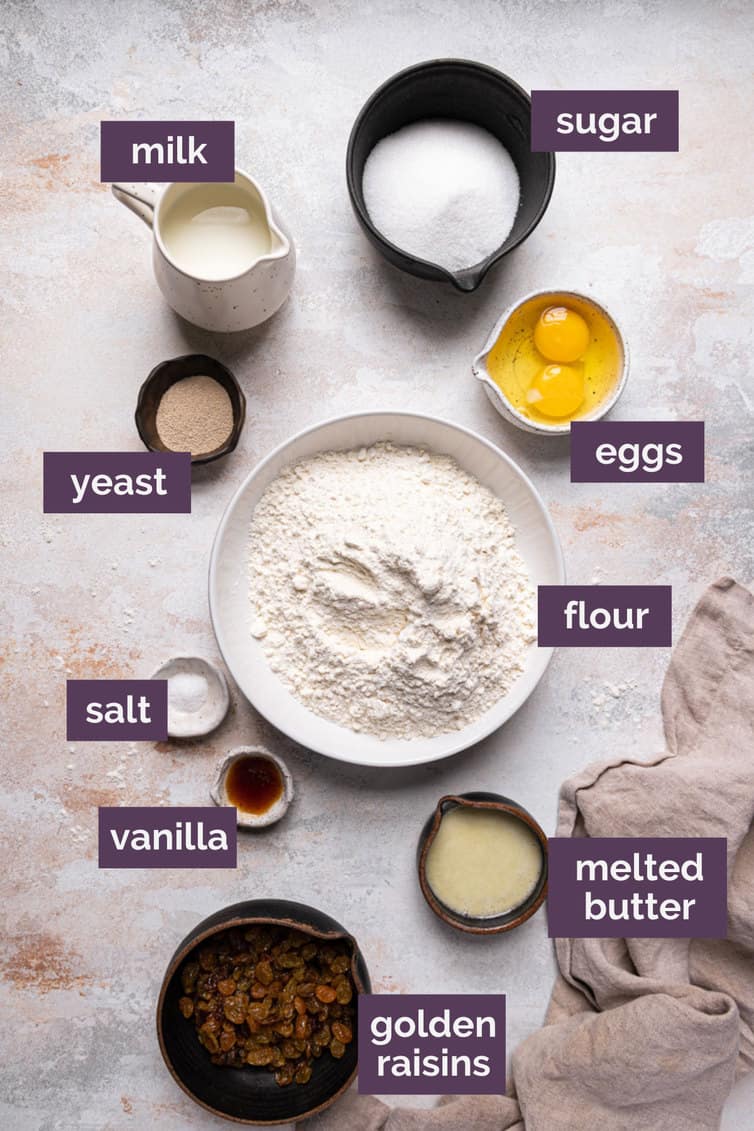
How to Make Paska Bread
I’m breaking this down into steps to walk you through the process; first, we make the dough, then shape the loaf, and bake the bread. Let’s do it!
Save This Recipe
Make the Bread Dough
- Activate the yeast: Warm the milk to a temperature between 100°F and 110°F (usually 30 seconds in the microwave should do the trick). Pour the warmed milk into a mixing bowl and sprinkle the yeast over top and let sit for 5 to 10 minutes, until foamy.

- Add liquid ingredients: Add sugar, butter, eggs, and vanilla to the bowl. Stir to combine.
- Make a shaggy dough: Add the flour and the salt into the bowl. Stir with a wooden spoon until a shaggy dough forms. If using, add the golden raisins.
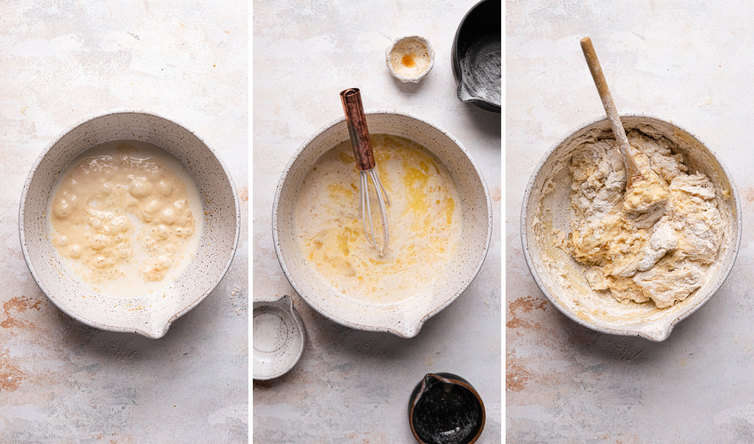
- Knead the dough: Using the dough hook, knead on medium-low speed until a smooth, shiny ball of dough is formed, 3 to 6 minutes, adding additional flour as necessary. (You can also knead by hand until a smooth ball is formed.)
- Let dough rise: Place the dough in a greased bowl and cover with plastic wrap. Place in a warm, draft0free spot until double in size, 1 to 2 hours.

Form and Shape the Dough
- Divide the dough: Punch the dough down and remove it from the bowl to a clean work area. Remove one-quarter of the dough and set aside.
- Shape the base: Form the large piece of dough into a ball and place in a 9-inch round cake pan or a springform pan.
- Braid the dough: Divide the remaining dough into three pieces and roll them each into 20-inch strands. Braid the three strands together for one long braid.
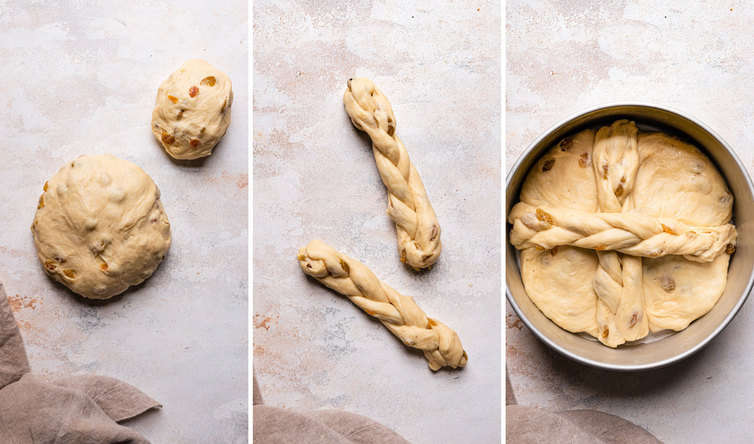
- Top the dough: Divide the braid in half and use it to form a cross over the top of the large ball of dough in the pan. Alternately you can wrap the braid in one length around the inside edge of the pan.
- Allow to rise: Cover lightly with plastic wrap and let rise until puffy and nearly double in size, 45 to 60 minutes.
Bake the Paska Bread
- Set the oven: Preheat the oven to 400°F.
- Make the egg wash: Whisk together the egg and water, then brush evenly all over the top of the dough and sprinkle with sugar.
- Bake the paska: Bake for 15 minutes, then reduce the oven temperature to 350°F and bake for an additional 25 to 30 minutes, until golden brown and an instant-read thermometer registers to 190°F. You can tent the pan with aluminum foil if it is browning too quickly.
- Cool the bread: Remove from the oven, turn the bread out of the pan, and place on a wire rack to cool completely.

Frosting and Glaze
We enjoy this paska bread recipe as is, but if you are looking to sweeten it up even more, try topping the bread with a simple powdered sugar and milk glaze or one of the following:
- Cream cheese frosting
- Vanilla buttercream frosting
- 7 minute frosting
- Orange glaze from my cranberry pound cake
Toppings and Mix-ins
- Traditional topping: Paska is often eaten with hrudka which is a bland, sweet custard similar to cheese.
- Other Toppings: Aside from frosting or a glaze you can top this sweet bread with sprinkles!
- Mix-ins: Chocolate chips, raisins or craisins, or candied fruits mix beautifully in the dough.
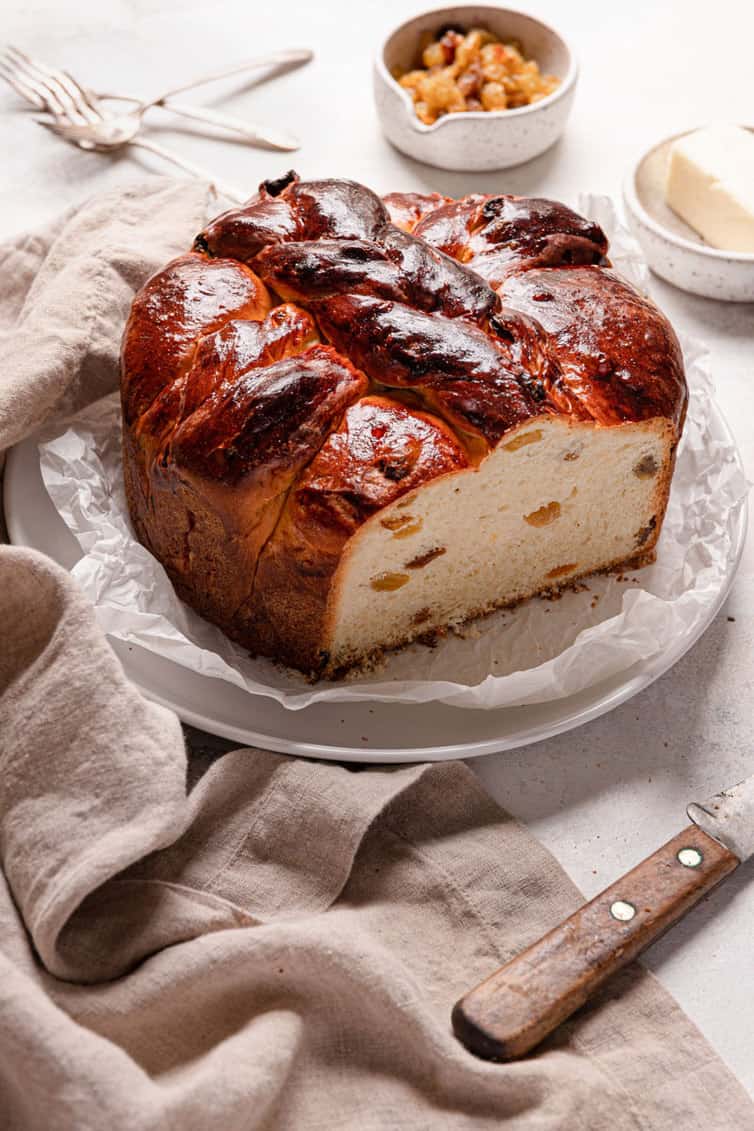
Storing, Freezing, Making Ahead
- Storing: Keep cooled paska bread in an air-tight container at room temperature for up to 3 days.
- Freezing: Wrap the cooled paska bread in a tight coat of plastic wrap followed by a layer of foil. Then store in a freezer-safe bag for up to 1 month. Thaw in the fridge overnight.
- Making ahead: You can make this 1 day in advance of serving it, to keep it as fresh as possible. Once cooled, wrap it tightly in two layers of plastic wrap and keep it at room temperature until serving.
- Leftovers: If you don’t want to freeze any of the leftover paska I would suggest slicing and using the bread in French toast or a bread pudding.

Other Delicious Easter Recipes
- Italian Easter Pie Recipe
- Bacon and Cheese Easter Bread
- Italian Easter Bread
- Koulourakia: Greek Easter Cookies
- Tsoureki: Greek Easter Bread
Paska Bread
This Easter, delight your family with a loaf of this sweet Paska Bread. Made with pantry staple ingredients, this raisin studded bread is sure to be a show-stopper! Slather it with butter, a sweet glaze, or homemade icing for a delicious treat!
If you make this Paska Bread recipe and love it, remember to stop back and give it a 5-star rating - it helps others find the recipe! ❤️️
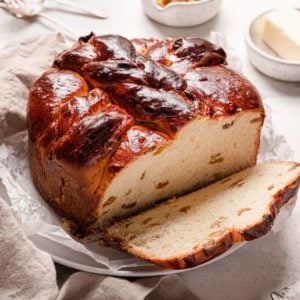
Paska Easter Bread
Ingredients
- 1 cup (240 ml) whole milk, warmed to 110 degrees F
- 2¼ teaspoons (2.25 teaspoons) instant yeast, 0.25-ounce packet
- ½ cup (99 g) granulated sugar
- ¼ cup (57 g) unsalted butter, melted and cooled to room temperature
- 2 eggs
- 1½ teaspoons (1.5 teaspoons) vanilla extract
- 4 cups (480 g) all-purpose flour
- ½ teaspoon (0.5 teaspoon) salt
- 1 cup (160 g) golden raisins, optional
For the Egg Wash:
- 1 egg
- 2 tablespoons water
- Coarse sugar, for sprinkling, optional
Instructions
- Warm the milk to between 100 to 110 degrees F (usually 30 seconds in the microwave does the trick!) and pour into a mixing bowl. Sprinkle the yeast over top and let sit for 5 to 10 minutes, until foamy.
- Add the sugar, butter, eggs, and vanilla extract, and stir to combine.
- Add the flour and the salt and stir with a wooden spoon until a shaggy dough forms. Add the golden raisins then, using the dough hook, knead on medium-low speed until a smooth, shiny ball of dough is formed, 3 to 6 minutes, adding additional flour as necessary. (You can also knead by hand until smooth ball is formed.) Place the dough in a greased bowl and cover with plastic wrap. Place in a warm, draft-free spot until doubled in size, 1 to 2 hours (rise time will depend on temperature and humidity in your kitchen).
- Punch dough down and remove from the bowl to a clean work area. Remove one-quarter of the dough and set aside. Form the large piece of dough into a ball and place in a 9-inch round cake pan or springform pan.
- Divide the remaining piece of dough into three pieces and roll them each out into a 20-inch strand. Braid the three strands together for one long braid. Divide the braid in half and use it to form a cross over the top of the large ball of dough in the pan. (Alternately, you can wrap the braid in one length around the inside edge of the pan.)
- Cover lightly with plastic wrap and let rise until puffy and nearly doubled in size, 45 to 60 minutes.
- Preheat oven to 400 degrees F.
- Whisk together the egg and water, then brush evenly all over the top of the dough and sprinkle with sugar, if desired.
- Bake for 15 minutes, then reduce the oven temperature to 350 degrees F and bake for an additional 25 to 30 minutes, until golden brown and an instant-read thermometer registers 190 degrees F. You can tent the pan with aluminum foil if it is browning too quickly. Remove from the oven, turn the bread out of the pan, and place it on a wire rack to cool completely.
Notes
- Equipment: 9-inch round cake pan or springform pan.
- Golden Raisins: You can substitute regular raisins, other chopped dried fruit, or omit entirely.
- Doubling Recipe: This recipe is easily doubled if you'd like to make two loaves - one for eating and one for gifting (or for your freezer!).
- Storing: Keep cooled paska bread in an air-tight container at room temperature for up to 3 days.
- Freezing: Wrap the cooled paska bread in a tight coat of plastic wrap followed by a layer of foil. Then store in a freezer-safe bag for up to 1 month. Thaw in the fridge overnight.
- Making ahead: You can make this 1 day in advance of serving it, to keep it as fresh as possible. Once cooled, wrap it tightly in two layers of plastic wrap and keep it at room temperature until serving.
- Leftovers: If you don't want to freeze any of the leftover paska I would suggest slicing and using the bread in French toast or a bread pudding.
Did you make this recipe?
Leave a review below, then snap a picture and tag @thebrowneyedbaker on Instagram so I can see it!
Photography by Dee Frances






My mom and family made Paska with orange and lemon and l think saffrons,has any one done it that way or have a recipe
Can you make the dough in a Bread Machine ?
Do you have a high altitude variation of this recipe?
Excellent recipe! Made twice. Some of the best I ever made,
this recipe is stunning and perfect.
my load turned out wonderfully and I can’t wait to make this every year!
I think baking at 400 is too much. Even after turning down to 350 and tenting over dried mine. Other than that, the recipe is tasty.
I love the simplicity of this recipe and it really looks beautiful when its done. But for some reason mine came out too dry– it was crumbling when I tried to cut it into slices. I did only bake it at 400 for 12 minutes and I tented it because it was getting dark at that point. I then lowered the oven temp to 335 for the 25 minutes because I suspected the oven was running too hot. The internal temp was 196 at the finish, so it wasn’t over baked to any huge degree. I suspect this recipe needs a bit more butter or maybe a touch of veg oil? What do you think?
I’ve now made 4 more breads, to share with family & friends after my family polished it off the one I made for Easter! It is really delicious and makes a Beautiful presentation. I did reduce the sugar as most people are already eating too many sweets! No one noticed! Thanks so much for remembering good heart warming foods to celebrate life with, Kathy
Hi, your bread looks beautiful. I would like to make this in a loaf pan. Do you know if it would fit in two loaf pans as written thank you.
I’m not Ukrainian, nor do I celebrate Easter, but sure am glad I stumbled onto this recipe. Mine did require an extra 1/4C of flour, and did rise beautifully in 90 minutes. Used half each brown raisins and dried cranberries.
Every BEB recipe I’ve used is in the faves folder! Thanks, Michelle, for another clearly written delicious recipe.
Can this be made in a regular bread loaf pan?
Thanks Dani
I have my Grandmother’s Babka recipe but prefer yours. I started making your recipe about 7 years ago. My Mom loved it, the bread was moist. I prefer making it in three (3) 8×4 inch loaf pans, 1 for my family and 2 to give to other family members. So glad I printed out your original recipe with the three (3) 8×4 inch pans.
Hi Barbara, I see your post on browneyedbaker’s bread recipe. I’m hoping to make it in loaf pans also. are the ingredients and measurements the same as shown here for the round single loaf? Thank you
The measurements are different. Here is the original recipe.
PASKA BREAD – brown eyed baker.com
2 packs active dry yeast
2 cups whole milk, warmed to 110 degrees
7 to 8 cups all purpose flour
1 cup granulated sugar
1/2 cup unsalted butter, melted and cooled
5 egg yolks lightly beaten
1 teaspoon salt
1 tablespoon vanilla
1 1/2 cups golden raisins
In a large bowl stir yeast into warm milk to dissolve and let sit for 5 minutes. Add 3 cups flour and mix with wooden spoon. Cover bowl with plastic wrap and place in warm, draft free area until dough has doubled in size.
Soak raisins in warm water for 30 minutes and pat dry.
Transfer dough to bowl of electric mixer and add sugar, melted butter, egg yolks, salt, vanilla, golden raisins and 4 cups of flour. Mix on low to medium speed until dough comes together, adding more flour as needed. Turn dough out on lightly floured surface and knead until it forms a smooth dough, about 5 minutes, adding more flour a tablespoon at a time, if needed. Divide the dough into 3 equal pieces and shape into loaves. Transfer to three (3) 8×4 inch greased loaf pans. Cover lightly with plastic wrap and let rise until doubled in size.
Preheat oven to 400 (375 for dark pans). Bake for 10 minutes, then reduce temperature to 350 (325 for dark pans) for an additional 30 – 35 minutes or until loaves are golden brown. If loaves are getting too brown, cover with foil. Allow to cool for 20 minutes then turn pans over on wire rack to cool.
Very good blog post. I absolutely appreciate this site. Keep writing!
Perfect timing! We would always get Paska from the bakery in town- when it went out of business many years later we never found a suitable replacement. This brings back so many memories- thank you!
Your Paska looks beautiful(reminiscent of panettone)! Have you ever made Placek(Polish coffee cake) at Easter? That’s what Polish Buffalonians usually bake and eat at Easter time, and I think that you would enjoy it, too! It is a sweet brioche-type yeast dough scented with vanilla, lemon rind and mace, with golden raisins, baked in a loaf pan, with a generous butter-sugar crumb topping(my mouth is watering just thinking of it). BTW, I love your blog, and I hope that you and your family have a wonderful Easter!!
I’m trying your recipe today for a test. My yeast wasn’t proofing so I added a teaspoon of sugar to it and it proofed perfectly. Hope it turns out as beautifully as yours looks.
First time making paska and I love this recipe. It came out fantastic. My family loved it. My recipe for my Easter paska from now on. Thank you!
Omg this is a great bread. Easy to follow directions and looks just like the picture . Soft inside crusty outside. I used cake pan and did not braid the dough for the top. Tastes great. Will absolutely be making this again. Wont just be Easter Bread might be my go to bread.
What a delicious bread! I used an 8” springform pan and added more baking time. This is an easy recipe to follow,. The texture is soft on the inside and crusty on the outside. Mine looks just like the picture!
I made this today. It got wonderful. Followed recipe. I did have to add 1/2 cup more flour because the dough was too sticky. Will make this again. It tastes fantastic and is so pretty with the braid on it. I did tent it after 15 minutes.
I haven’t tasted this yet, but mine started to get really dark during the 400 degree first 15 minutes. I tented it when I lowered the temperature, but it was already really dark brown. I want to make it again, not so dark, but how would you suggest that I do the temperatures? Maybe 10 minutes at 400 then lower to 350?? It is too hot to cut yet, but we will eat it today and I will try another for Easter. This is a good recipe, but the baking instructions are not working for me. I use an oven thermometer so I know it is accurate. Help Michelle!
Hi Karen, Yes, I would do the 400 degrees for less time, then cover and you may need to bake a little longer at 350. I hope you enjoyed the bread once you sliced into it! :)
Hiiii I made this and it was absolutely gorgeous! Thank you so much. We are a real raisin family so loved it more so.
I wanted to ask if I could bake it on a baking sheet rather than a pan as it got quite big. Also if I add some extra cashews and cranberries into it would I need to adjust anything?
Many thanks x
Hi Sophia, I’m so glad your family loved it! I think baking it free form would work, it would just spread out more, instead of baking “up”. Cashews and cranberries would be delish! No need to change anything (but rise time may take a smidge longer).
Gorgeous recipe! Just one note for everyone, though, paska/Pascha does not translate to “Easter”, it’s literal translation is “passover”. Somewhere down the line when translating the Bible into English, I think it was the King James Version, the translators wanted to differentiate between the Jewish celebration of passover and the Christian feast of Christ’s resurrection (which is Passover fulfilled). In Orthodox communities and the Christian eastern world, Pascha is still the word for this Christian feast, but in the west it is called Easter because that was a word for a celebration of spring time in German (which is where you get all your run of the mill “Easter is really a pagan tradition” rubbish) that they thought would be acceptable so as not to be confused with the Jewish celebration.
Thanks Michelle for sharing these wonderful Easter recipes. Every year at Christmas I use your recipe to make Nut Roll. This year I have two left to serve at Easter. I’ve made your Homemade Peanut Butter eggs — one word – AMAZING.
I’ll definitely be making Paska this year. I was fascinated by the Easter Pie, although I don’t know where in Ohio I could get Basket cheese.
Thanks for all the delicious recipes — I can smell them now!
Do you know where I can get an Italian Easter bread recipe? My grandma Rosa used to do them with the anise oil favoring. They were braided & had colored eggs intertwined in the braiding. They were iced green, white or yellow & had jimmies on top. Her whole house smelled like anise for days after making these. Lol. I’d love to make them in her honor but no one has ever been able to find her recipe. I’m sure it was in her head & there was no recipe written down because thats how she did her whiskey cakes every Christmas. Thank you. Tres :)
Hi Teresa, Yes I have a recipe for Italian Easter Bread! It’s from my husband’s great-grandmother: https://www.browneyedbaker.com/italian-easter-bread-recipe/
Hi! I’m from Poland, and IT’S almost for sure not Polish :) maybe Ukrainiqn or Russian? I think it’s also called more like Pascha there :)
Shouldn’t a tablespoon of sugar be added to the yeast and milk to make it ferment and rise quicker? I am following your recipe and my dough is not rising at all. It’s been a couple of hours already.
I had this same issue with not rising. In my other paska recipe it calls for sugar and it rises with no problems.
We love the taste of this bread. I make it with raisins. The only comment is it doesn’t raise very much, is this normal?
Thank you for posting this recipe. My grandother, who was Russian living in the Ukraine, used to make a bread that looked almost indentical to this, including the golden raisins. I lost the recipe, so I was excited when I saw your post. I’m really looking forward to making this bread!
My grandmother was polish, grandfather Russian. Grandma would make paska but she would bake it in a 2lb coffee can. It came out looking like a big mushroom and was great smeared with butter. I’m going to try this recipe
Was I supposed to follow the yeast packet directions before I mixed it with the milk. The loaves seem to be taking forever to double.
Mine took a lot longer to rise, too. Almost two hours just to begin and a full three hours to double. I think next time I’ll add a bit of sugar to the yeast and milk mixture to get it going. Without the sugar, it didn’t foam at all, and I think that might have been problem. Overall, the bread came out beautifully, it just took a very long time to rise.